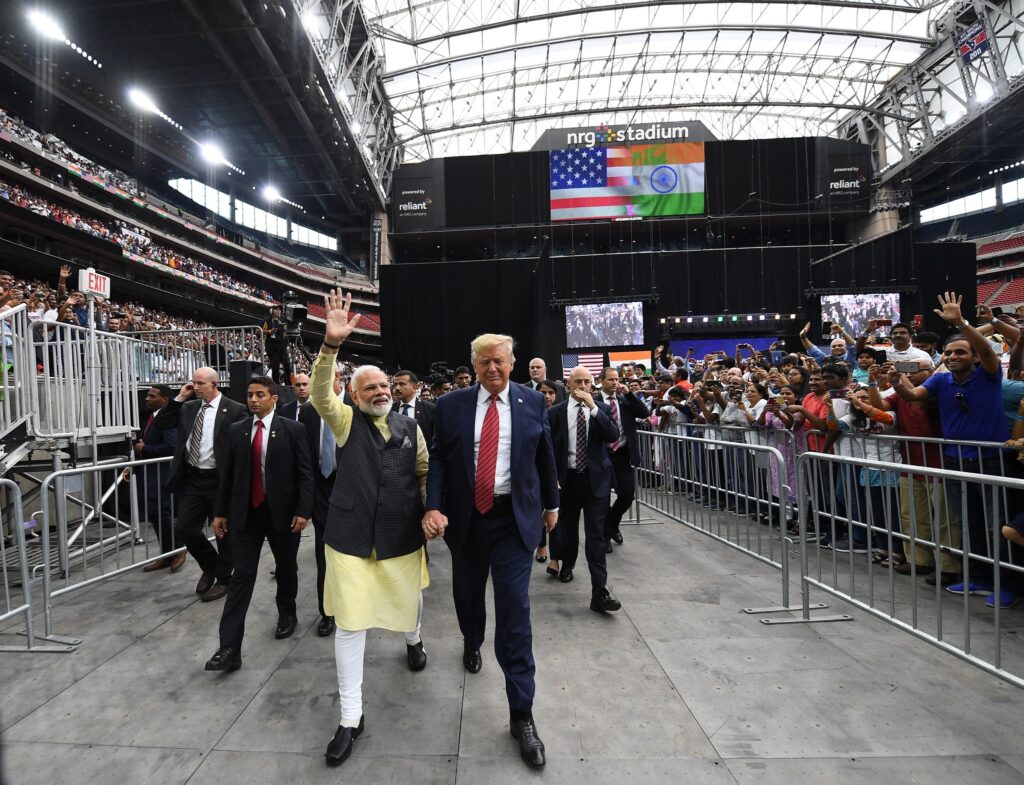India’s Diplomatic Balancing Act: What Trump’s Possible Return Means for U.S.-India Relations
6 min read
Introduction: A Crucial Moment in India-U.S. Relations
As the U.S. contemplates the implications of a possible second term for Donald Trump, countries around the world are reassessing their strategic approaches to U.S. relations—including India, a critical partner in the Indo-Pacific region. The U.S. is India’s largest trading partner, and the nations share interests in security, economic growth, and regional stability. Yet, Trump’s “America First” policies, as seen in his first term, often introduced challenges and unpredictability that prompted India to tread carefully. While Trump champions closer ties with India on many fronts, a resurgence in his protectionist policies could strain the relationship.
This analysis dives into how Trump’s leadership style might impact India across key areas like defense, trade, immigration, and regional security.
Strengthening Defense and Strategic Ties: A Double-Edged Sword
Historical Progress in Security Cooperation
During Trump’s first term, the U.S. and India expanded defense cooperation, with Trump’s administration formally elevating India to “Major Defense Partner” status in 2016. This milestone made India eligible for advanced military technologies previously restricted to U.S. allies. The two countries also signed foundational agreements, such as the Communications Compatibility and Security Agreement (COMCASA) and Basic Exchange and Cooperation Agreement (BECA), which allowed India to access advanced military hardware and intelligence-sharing channels.
Indo-Pacific and China’s Influence
India’s strategic importance as a counterbalance to China aligns well with Trump’s interest in a “free and open Indo-Pacific,” a concept designed to limit Beijing’s influence in the region. Trump’s hawkish stance on China was welcomed by New Delhi, especially amid ongoing tensions between India and China along the Line of Actual Control (LAC). With China expanding its footprint in South Asia, particularly through the Belt and Road Initiative, Trump’s likely confrontational approach could strengthen the Quad (Quadrilateral Security Dialogue)—an alliance involving the U.S., Japan, Australia, and India—intended to ensure a balance of power in the Indo-Pacific region.
Strategic Risks
However, Trump’s preference for unilateralism over multilateral diplomacy could present challenges. While India values U.S. support in defense, it also seeks to maintain strategic autonomy. New Delhi may find itself balancing between closer security ties with Washington and its need to remain non-aligned, particularly given its dependence on Russian military equipment and its long-standing non-alignment policy.
Economic Implications: A Rocky Path in Trade Relations
A History of Trade Disputes
Despite growing defense ties, the Trump administration took a hard stance on trade with India, labeling it a “tariff king.” This culminated in the U.S. withdrawing India from its Generalized System of Preferences (GSP) program in 2019, which had allowed India to export certain products to the U.S. duty-free. Trump’s return could mean renewed pressure for India to reduce its trade surplus with the U.S., address intellectual property concerns, and lower tariffs on American goods.
Impact on Key Sectors
A Trump administration could potentially impose additional tariffs on Indian goods, which may impact key sectors such as pharmaceuticals, textiles, and IT services—industries where India plays a significant role in the U.S. economy. For instance, the Indian IT sector, which heavily relies on U.S. clients, could face higher operational costs if Trump pursues restrictive measures on services or labor.
Opportunities for Economic Diversification
India’s advantage in the global market has grown as countries seek to diversify supply chains away from China. With its “Make in India” initiative, New Delhi aims to position itself as an alternative to China for manufacturing. Trump’s stance on reducing dependency on Chinese goods could offer India an opportunity to attract U.S. investment, particularly in electronics, pharmaceuticals, and critical technology supply chains.
Immigration Policy and the Indian Diaspora: A Sensitive Issue
H-1B Visa Reforms
Immigration is another area where Trump’s policies significantly impact India, as Indian nationals account for a large share of H-1B visa recipients in the U.S. During his first term, Trump tightened H-1B visa regulations, complicating matters for Indian professionals in the U.S. and affecting Indian companies with American operations. With a renewed “America First” focus, Trump could impose further restrictions on skilled-worker visas, which could impact both India’s tech sector and Indian students studying or working in the U.S.
Anti-Immigrant Sentiment and the Indian Community
While Trump has celebrated Indian-American support, his administration’s hardline stance on immigration led to rising anti-immigrant sentiment. Indian-Americans, an influential and growing community, have faced increased discrimination under such policies. For New Delhi, there are concerns that further immigration restrictions could alienate the diaspora community, impacting remittances and complicating cross-border family relations.
Navigating the U.S.-China-India Triangle
China’s Aggression and India’s Response
China’s rise as a dominant power in Asia has directly impacted India, especially in contested border regions. In recent years, the LAC tensions highlighted India’s need for strong alliances to counterbalance China’s aggressive tactics. Trump’s inclination to confront China aligns with India’s interests, as both countries seek to counter China’s influence in South Asia and beyond.
Balancing Ties with Russia and the U.S.
India has traditionally balanced its relations with the U.S. and Russia, both major arms suppliers. However, Trump’s re-election could complicate this balance, particularly if Washington increases pressure on countries maintaining close ties with Russia, especially given Russia’s ongoing conflict with Ukraine. India may have to navigate carefully between sustaining its strategic autonomy and meeting U.S. expectations, particularly if the U.S. links its defense support to India’s stance on Russia.
Diplomatic Approach and Strategic Autonomy: India’s Calculated Path Forward
Non-Alignment 2.0: India’s Strategic Diplomacy
India’s diplomatic approach in recent years has been shaped by a “non-alignment 2.0” policy, which allows it to collaborate with multiple global powers without over-committing to any single bloc. While the U.S. is a valuable ally, New Delhi continues to engage with countries across the spectrum, from Russia and Iran to members of the European Union.
Risks of Relying on an Unpredictable Partner
While the Trump administration’s commitment to strengthening U.S.-India ties was clear, the unpredictability of Trump’s policies raises concerns. His frequent shifts on issues like military deployments, international trade, and climate policy make it difficult for allies to rely on stable support. India’s response to a second Trump term may be a blend of proactive collaboration with the U.S. on mutual interests—while preserving flexibility to pivot if needed.
Potential for Indian-Led Multilateral Efforts
India’s recent initiatives in global forums, including the G20, have demonstrated its aspiration to play a leading role in multilateral settings. India could leverage its position to encourage balanced multilateralism and greater global cooperation on issues like climate change, digital governance, and trade transparency.
Conclusion: A Balancing Act for New Delhi
India’s approach to a potential Trump return is likely to be cautious, calculated, and flexible. The Indian government has much to gain from a strong partnership with the U.S., especially in terms of defense, countering China, and boosting trade. Yet, Trump’s unpredictability, protectionist stance, and potentially divisive immigration policies necessitate a careful approach from New Delhi.
As the global order evolves, India’s capacity to navigate its relationship with both the U.S. and its other allies will be vital. A second Trump term could bring both opportunities and challenges, but India’s focus will likely remain on strategic autonomy, economic resilience, and regional stability. The path forward will require a delicate balance—one that preserves India’s interests while fostering the benefits of U.S. partnership.







